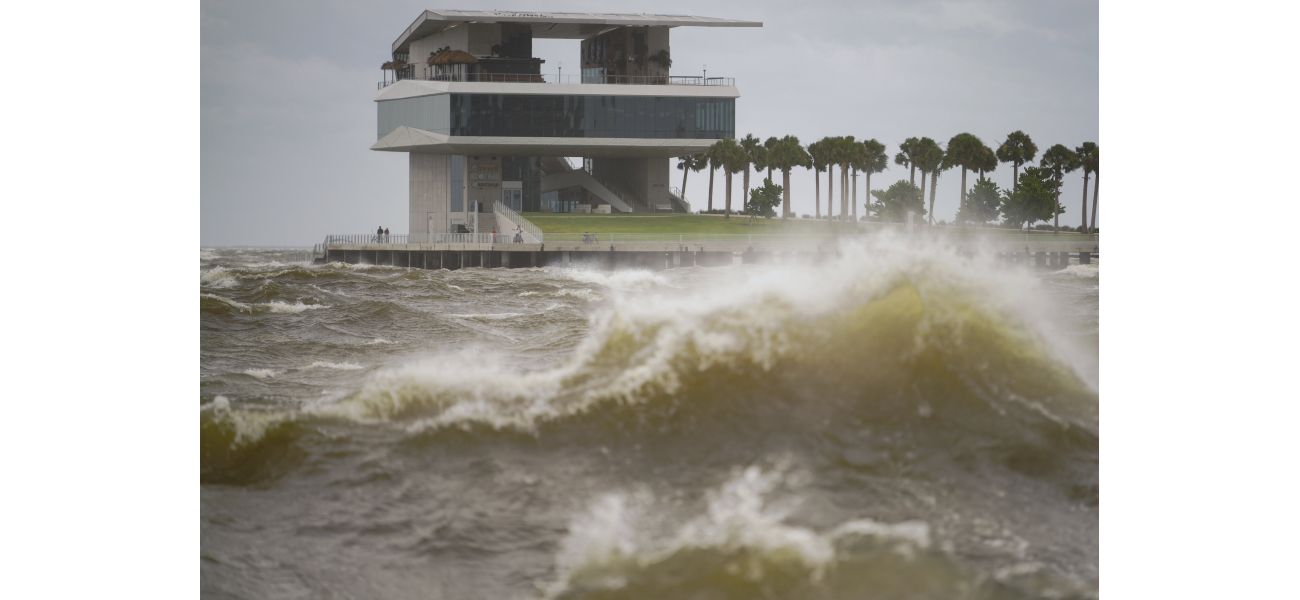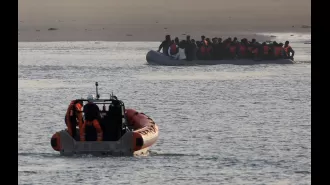Hurricane Helene reaches Florida's northwest coast as a Category 4 storm.
States declare emergencies as 250,000 properties lose power due to strong winds.
September 27th 2024.

A powerful hurricane named Helene has arrived in the Big Bend area of Florida's northwestern coast, bringing with it catastrophic winds, rain, and a dangerous storm surge. As it made landfall on Thursday evening, forecasters warned of the potential for flash floods and widespread damage across the southeastern United States.
As the storm approached, reports of its impact began to surface. In Georgia, two people were tragically killed in a possible tornado, while in Florida, Governor Ron DeSantis confirmed the death of one person who was driving on Interstate 4 when a sign fell onto their car. The storm also caused widespread power outages, leaving over one million homes and businesses without electricity in Florida and over 50,000 in Georgia.
States of emergency were declared in several states, including Florida, Georgia, the Carolinas, Virginia, and Alabama. The potential for more fatalities and property damage is high, with DeSantis warning that the storm could cause significant loss of life and destruction.
As Helene wreaked havoc on the Gulf Coast, another storm, John, was causing concern in the Pacific. After weakening and then re-strengthening, John was downgraded to a tropical storm as it moved along the coast of Mexico's Michoacan state. Despite this, it still posed a threat to the area with its strong winds and potential for flash flooding and mudslides.
Meanwhile, in the Atlantic Ocean, Tropical Storm Isaac formed on Wednesday and is expected to continue strengthening as it moves away from the US. Forecasters predict that it may become a hurricane by the end of the week.
In the midst of the chaos and devastation caused by these storms, officials are urging people to stay safe and take necessary precautions. DeSantis emphasized the dangerous conditions and urged people to hunker down and stay alert. He also expressed concern for the well-being of those affected and asked for prayers for the individuals and communities impacted by the storms.
As the night went on, Helene made landfall in northwestern Florida as a Category 4 hurricane, with winds reaching 140 mph. The National Hurricane Center warned of potential storm surges up to 20 feet, particularly in Florida's Apalachee Bay. Hurricane and flash flood warnings extended far beyond the coast, reaching into northern Georgia and western North Carolina.
The impact of the storm was widespread, with hundreds of thousands of people in Florida and other states left without power. In the Big Bend area, where Helene made landfall, the majority of customers were without electricity. As the night progressed, the number of power outages continued to rise.
In the Pacific, John was no longer a hurricane, having been downgraded to a tropical storm. However, it was still causing concern as it slowly moved along Mexico's coast. The US National Hurricane Center reported sustained winds of 70 mph and warned of potential flash flooding in coastal areas. John had previously made landfall as a Category 3 hurricane in Acapulco, causing significant damage.
Despite weakening as it moved inland, John reemerged over the ocean and strengthened back into a hurricane. It was expected to weaken again on Thursday night and into Friday.
As these powerful storms continue to wreak havoc and cause devastation, it is important for everyone to remain vigilant and take necessary precautions to stay safe. Our thoughts and prayers are with those affected by these natural disasters.
The powerful Hurricane Helene struck the Big Bend area of Florida's northwestern coast on Thursday evening as a Category 4 storm. Forecasters warned of the potential for catastrophic storm surges, destructive winds, heavy rains, and flash floods across the southeastern United States.
As the storm approached, authorities in Georgia reported two deaths possibly caused by a tornado, and Florida Governor Ron DeSantis confirmed one fatality when a sign fell on a car on Interstate 4. The storm also caused widespread power outages, affecting over 1 million homes and businesses in Florida and 50,000 in Georgia.
The situation was dire enough for several states to declare a state of emergency, including Florida, Georgia, the Carolinas, Virginia, and Alabama. Meanwhile, in the Pacific, former Hurricane John regained strength as a hurricane and threatened Mexico's western coast with flash floods and mudslides. It was later downgraded to a tropical storm as it moved along the coast of Michoacan.
In the Atlantic Ocean, Tropical Storm Isaac formed on Wednesday and was expected to become a hurricane by the end of the week as it moved away from the United States.
Governor DeSantis expressed his concerns about the dangerous conditions and urged people to stay safe and seek shelter. He also warned that there could be more fatalities and property damage as the storm progressed. He asked for prayers for those who might be affected by the storm and announced that 3,500 National Guardsmen were ready to respond.
Hurricane Helene made landfall on Thursday night in northwestern Florida as a Category 4 storm with maximum sustained winds of 140 mph. The National Hurricane Centre in Miami reported that the storm hit near Perry, Florida, in the Big Bend area. Forecasters warned of catastrophic flooding along the Gulf Coast, particularly in Apalachee Bay.
The hurricane warning and flash flood warning extended beyond the coast to northern Georgia and western North Carolina. As of 11 p.m. EDT, over 885,000 customers in Florida were without power, with the majority of outages in the Big Bend area where Hurricane Helene was expected to make landfall.
Meanwhile, former Hurricane John was downgraded to a tropical storm as it moved slowly along the coast of Michoacan. The storm, which initially hit Mexico on Monday as a Category 3 hurricane, caused severe damage and has since reformed as a tropical storm. The US National Hurricane Centre warned of potential flash floods and sustained winds of 70 mph.
The storm is expected to weaken in the coming days, but the threat of severe weather and damage remains. As the situation continues to develop, authorities and residents are urged to stay informed and take necessary precautions to stay safe.
As the storm approached, reports of its impact began to surface. In Georgia, two people were tragically killed in a possible tornado, while in Florida, Governor Ron DeSantis confirmed the death of one person who was driving on Interstate 4 when a sign fell onto their car. The storm also caused widespread power outages, leaving over one million homes and businesses without electricity in Florida and over 50,000 in Georgia.
States of emergency were declared in several states, including Florida, Georgia, the Carolinas, Virginia, and Alabama. The potential for more fatalities and property damage is high, with DeSantis warning that the storm could cause significant loss of life and destruction.
As Helene wreaked havoc on the Gulf Coast, another storm, John, was causing concern in the Pacific. After weakening and then re-strengthening, John was downgraded to a tropical storm as it moved along the coast of Mexico's Michoacan state. Despite this, it still posed a threat to the area with its strong winds and potential for flash flooding and mudslides.
Meanwhile, in the Atlantic Ocean, Tropical Storm Isaac formed on Wednesday and is expected to continue strengthening as it moves away from the US. Forecasters predict that it may become a hurricane by the end of the week.
In the midst of the chaos and devastation caused by these storms, officials are urging people to stay safe and take necessary precautions. DeSantis emphasized the dangerous conditions and urged people to hunker down and stay alert. He also expressed concern for the well-being of those affected and asked for prayers for the individuals and communities impacted by the storms.
As the night went on, Helene made landfall in northwestern Florida as a Category 4 hurricane, with winds reaching 140 mph. The National Hurricane Center warned of potential storm surges up to 20 feet, particularly in Florida's Apalachee Bay. Hurricane and flash flood warnings extended far beyond the coast, reaching into northern Georgia and western North Carolina.
The impact of the storm was widespread, with hundreds of thousands of people in Florida and other states left without power. In the Big Bend area, where Helene made landfall, the majority of customers were without electricity. As the night progressed, the number of power outages continued to rise.
In the Pacific, John was no longer a hurricane, having been downgraded to a tropical storm. However, it was still causing concern as it slowly moved along Mexico's coast. The US National Hurricane Center reported sustained winds of 70 mph and warned of potential flash flooding in coastal areas. John had previously made landfall as a Category 3 hurricane in Acapulco, causing significant damage.
Despite weakening as it moved inland, John reemerged over the ocean and strengthened back into a hurricane. It was expected to weaken again on Thursday night and into Friday.
As these powerful storms continue to wreak havoc and cause devastation, it is important for everyone to remain vigilant and take necessary precautions to stay safe. Our thoughts and prayers are with those affected by these natural disasters.
The powerful Hurricane Helene struck the Big Bend area of Florida's northwestern coast on Thursday evening as a Category 4 storm. Forecasters warned of the potential for catastrophic storm surges, destructive winds, heavy rains, and flash floods across the southeastern United States.
As the storm approached, authorities in Georgia reported two deaths possibly caused by a tornado, and Florida Governor Ron DeSantis confirmed one fatality when a sign fell on a car on Interstate 4. The storm also caused widespread power outages, affecting over 1 million homes and businesses in Florida and 50,000 in Georgia.
The situation was dire enough for several states to declare a state of emergency, including Florida, Georgia, the Carolinas, Virginia, and Alabama. Meanwhile, in the Pacific, former Hurricane John regained strength as a hurricane and threatened Mexico's western coast with flash floods and mudslides. It was later downgraded to a tropical storm as it moved along the coast of Michoacan.
In the Atlantic Ocean, Tropical Storm Isaac formed on Wednesday and was expected to become a hurricane by the end of the week as it moved away from the United States.
Governor DeSantis expressed his concerns about the dangerous conditions and urged people to stay safe and seek shelter. He also warned that there could be more fatalities and property damage as the storm progressed. He asked for prayers for those who might be affected by the storm and announced that 3,500 National Guardsmen were ready to respond.
Hurricane Helene made landfall on Thursday night in northwestern Florida as a Category 4 storm with maximum sustained winds of 140 mph. The National Hurricane Centre in Miami reported that the storm hit near Perry, Florida, in the Big Bend area. Forecasters warned of catastrophic flooding along the Gulf Coast, particularly in Apalachee Bay.
The hurricane warning and flash flood warning extended beyond the coast to northern Georgia and western North Carolina. As of 11 p.m. EDT, over 885,000 customers in Florida were without power, with the majority of outages in the Big Bend area where Hurricane Helene was expected to make landfall.
Meanwhile, former Hurricane John was downgraded to a tropical storm as it moved slowly along the coast of Michoacan. The storm, which initially hit Mexico on Monday as a Category 3 hurricane, caused severe damage and has since reformed as a tropical storm. The US National Hurricane Centre warned of potential flash floods and sustained winds of 70 mph.
The storm is expected to weaken in the coming days, but the threat of severe weather and damage remains. As the situation continues to develop, authorities and residents are urged to stay informed and take necessary precautions to stay safe.
[This article has been trending online recently and has been generated with AI. Your feed is customized.]
[Generative AI is experimental.]
0
0
Submit Comment





